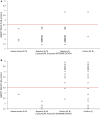Evaluation of Orthogonal Testing Algorithm for Detection of SARS-CoV-2 IgG Antibodies
- PMID: 32894753
- PMCID: PMC7499512
- DOI: 10.1093/clinchem/hvaa210
Evaluation of Orthogonal Testing Algorithm for Detection of SARS-CoV-2 IgG Antibodies
Abstract
Background: Severe acute respiratory syndrome coronavirus 2 (SARS-CoV-2) antibody testing is an important tool in assessment of pandemic progress, contact tracing, and identification of recovered coronavirus disease 2019 (COVID-19) patients. We evaluated an orthogonal testing algorithm (OTA) to improve test specificity in these use cases.
Methods: A two-step OTA was applied where individuals who initially tested positive were tested with a second test. The first-line test, detecting IgG antibodies to the viral nucleocapsid protein, was validated in 130 samples and the second-line test, detecting IgG antibodies to the viral spike protein in 148 samples. The OTA was evaluated in 4333 clinical patient specimens. The seropositivity rates relative to the SARS-CoV-2 PCR positivity rates were evaluated from our entire patient population data (n = 5102).
Results: The first-line test resulted in a clinical sensitivity of 96.4% (95% CI; 82.3% to 99.4%), and specificity of 99.0% (95% CI; 94.7% to 99.8%), whereas the second-line test had a sensitivity of 100% (95% CI; 87.1% to 100%) and specificity of 98.4% (95% CI; 94.2% to 99.5%). Using the OTA, 78/98 (80%) of initially positive SARS-CoV-2 IgG results were confirmed with a second-line test, while 11/42 (26%) of previously diagnosed COVID-19 patients had no detectable antibodies as long as 94 days post PCR diagnosis.
Conclusion: Our results show that an OTA can be used to identify patients who require further follow-up due to potential SARS CoV-2 IgG false positive results. In addition, serological testing may not be sufficiently sensitive to reliably detect prior COVID-19 infection.
© American Association for Clinical Chemistry 2020. All rights reserved. For permissions, please email: journals.permissions@oup.com.
Figures


References
-
- U.S. Food and Drug Administration (FDA). EUA Authorized Serology Test Performance. https://www.fda.gov/medical-devices/emergency-situations-medical-devices... (Accessed August 2020).
-
- Infantino M, Damiani A, Gobbi FL, Grossi V, Lari B, Macchia D, et al.Serological assays for SARS-CoV-2 infectious disease: benefits, limitations and perspectives. Isr Med Assoc J 2020;22:203–10. - PubMed
-
- Whitman JD, Hiatt J, Mowery CT, Shy BR, Yu R, Yamamoto TN, et al. Test performance evaluation of SARS-CoV-2 serological assays. preprint at https://www.medrxiv.org/content/10.1101/2020.04.25.20074856v2 (2020). - DOI
MeSH terms
Substances
Grants and funding
LinkOut - more resources
Full Text Sources
Medical
Miscellaneous

